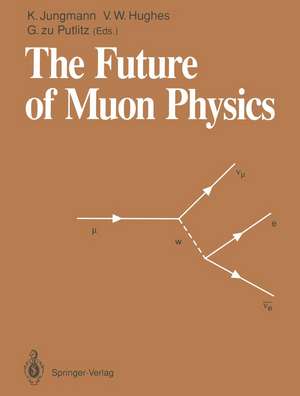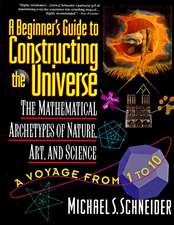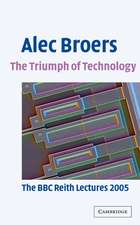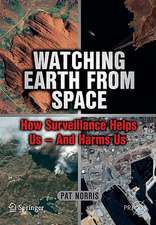The Future of Muon Physics: Proceedings of the International Symposium on The Future of Muon Physics, Ruprecht-Karls-Universität Heidelberg, Heidelberg, Federal Republic of Germany, 7–9 May, 1991
Editat de Klaus Jungmann, Vernon W. Hughes, Gisbert zu Putlitzen Limba Engleză Paperback – 22 aug 2014
Preț: 401.03 lei
Nou
Puncte Express: 602
Preț estimativ în valută:
76.74€ • 82.06$ • 63.98£
76.74€ • 82.06$ • 63.98£
Carte tipărită la comandă
Livrare economică 17 aprilie-01 mai
Preluare comenzi: 021 569.72.76
Specificații
ISBN-13: 9783642779626
ISBN-10: 364277962X
Pagini: 320
Ilustrații: VII, 307 p. 102 illus.
Dimensiuni: 210 x 279 x 17 mm
Greutate: 0.72 kg
Ediția:Softcover reprint of the original 1st ed. 1992
Editura: Springer Berlin, Heidelberg
Colecția Springer
Locul publicării:Berlin, Heidelberg, Germany
ISBN-10: 364277962X
Pagini: 320
Ilustrații: VII, 307 p. 102 illus.
Dimensiuni: 210 x 279 x 17 mm
Greutate: 0.72 kg
Ediția:Softcover reprint of the original 1st ed. 1992
Editura: Springer Berlin, Heidelberg
Colecția Springer
Locul publicării:Berlin, Heidelberg, Germany
Public țintă
ResearchDescriere
This volume comprises a collection of invited papers presented at the interna tional symposium "The Future of Muon Physics", May 7-9 1991, at the Ruprecht Karls-Universitat in Heidelberg. In the inspiring atmosphere of the Internationales Wissenschaftsforum researchers working worldwide at universities and at many inter national accelerator centers came together to review the present status of the field and to discuss the future directions in muon physics. The muon, charged lepton of the second generation, was first oberved some sixty years ago~ Despite many efforts since, the reason for its existence still remains a secret to the scientific community challenging both theorists and experimentalists. In modern physics the muon plays a key role in many topics of research. Atomic physics with negative muons provides excellent tests of the theory of quantum electrodynamics and of the electro-weak interaction and probes nuclear properties. The. purely leptonic hydrogen-like muonium atom allows tests of fun damental laws in physics and the determination of precise values for fundamental constants. New measurements of the anomalous magnetic moment of the muon will probe the renormalizability of the weak interaction and will be sensitive to physics beyond the standard model. The muon decay is the most carefully studied weak process. Searches for rare decay modes of muons and for the conversion of muonium to antimuonium examine the lepton number conservation laws and new speculative theories. Nuclear muon capture addresses fundamental questions like tests of the CPT theorem.
Cuprins
Preface.- Our favourite — the muon.- Opening of the Symposium “The Future of Muon Physics”, May 7–9, 1991, Ruprecht-Karls-Universität Heidelberg.- Muon physics — survey.- Two-body QED bound states.- Electro-weak interaction in muonic atoms.- Some open problems in muon physics.- Muonium.- Reactions of muonic hydrogen isotopes.- Muonic atom spectroscopy.- Laser spectroscopy of muonic atoms.- Time-Fourier spectroscopy of muonium.- Laser induced transition 3D-3P in muonic helium.- Muon g-2: theory.- The CERN (g-2) measurements.- The electric dipole moment of the muon.- The new muon (g-2) experiment at Brookhaven.- Muon decay.- Measurements of the muon-neutrino mass.- Rare muon decays and physics beyond the standard model.- The neutrinos in muon decay.- Rare decays: experiment.- The future of muon physics: nuclear muon capture.- Laser polarized muonic atoms.- Radiative muon capture on hydrogen.- Muon capture in hyperfine states of muonic deuterium and induced pseudoscalar form factor.- Photon-hadron interactions revisited in deep inelastic muon scattering.- Deep inelastic scattering of polarized muons.- Attempts to understand g1(x) and g2(x).- Medium energy neutrino physics.- The future of neutrino physics.- Muon-catalyzed fusion theory.- Resonant formation of dt? mesic molecules in the triple H2 + D2 + T2 mixture.- Muon science research with pulsed muons at UT-MSL/KEK.- Existing muon beams at LAMPF.- Muon beams and facilities at TRIUMF.- The ISIS pulsed muon facility.- Muon beams at PSI.- Very slow positive muons.- Phase space compression of low energy muon beams.- A pulsed lepton source at LAMPF.- Kicked surface muon beams.- Recent applications of ?+ SR in magnetism: novel magnetic features in heavy electron compounds.- Muons and pions as probes in condensed matter.- Ephemeral and/or coloured muonic hydrogen atoms.- PILAC: a pion linac facility for 1-GeV pion physics at LAMPF.- Accelerator plans at PSI.- Accelerator plans at TRIUMF.- Muon facility plans towards JHP.- Conference summary.- Index of contributors.










